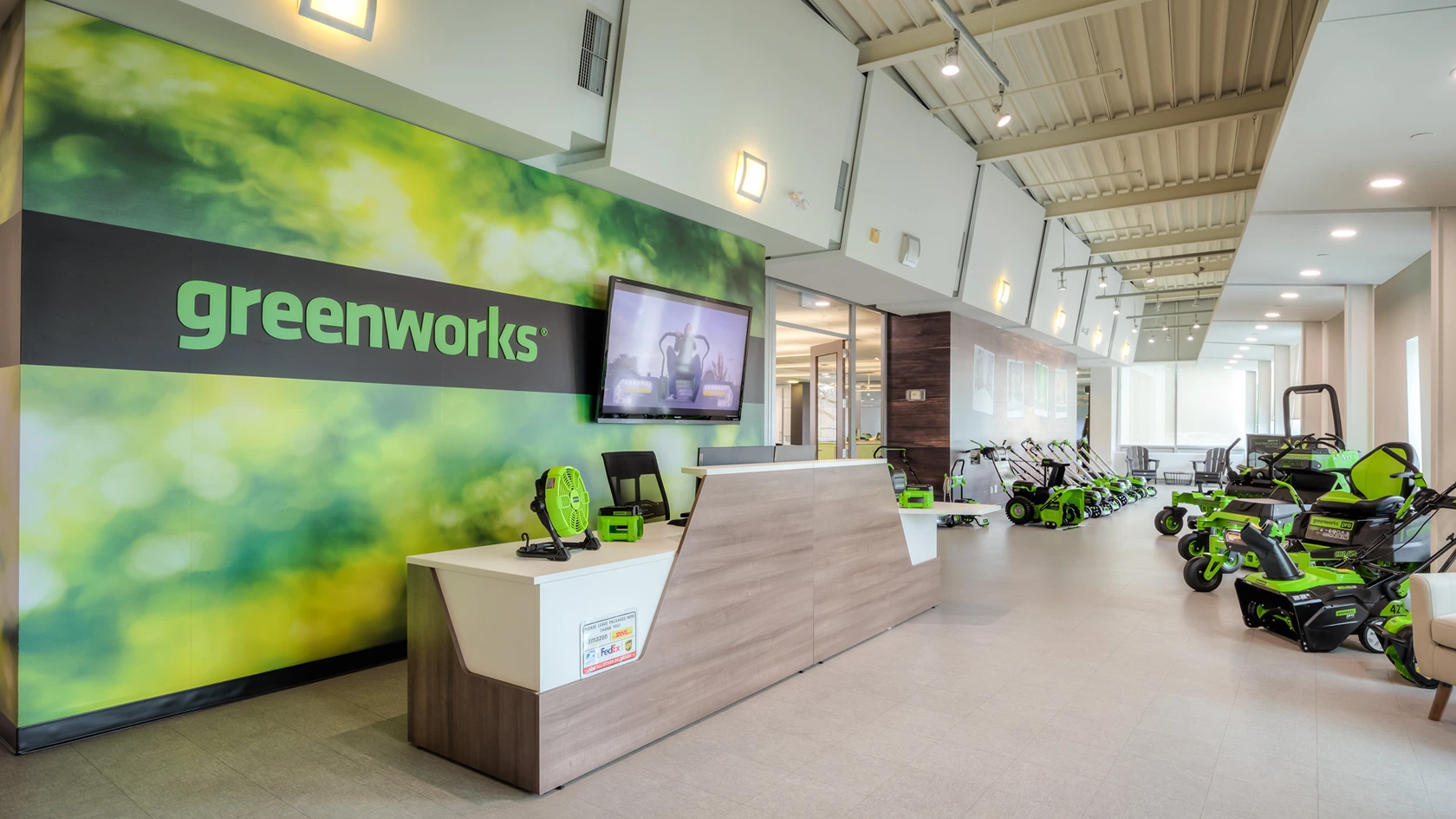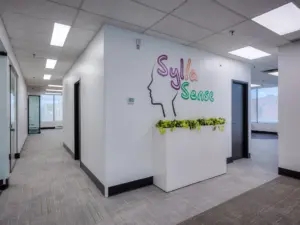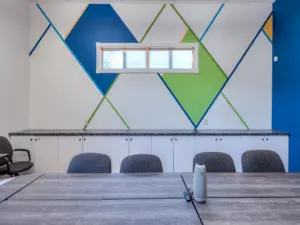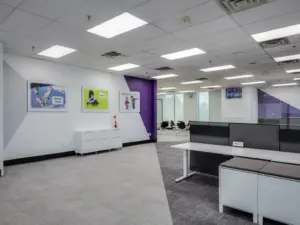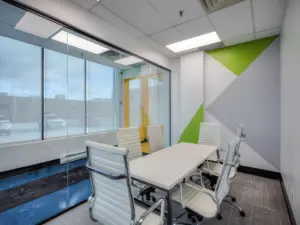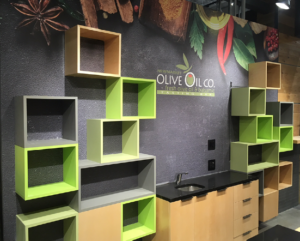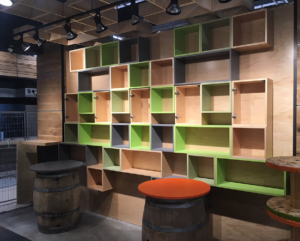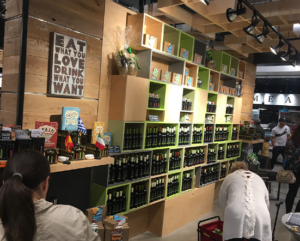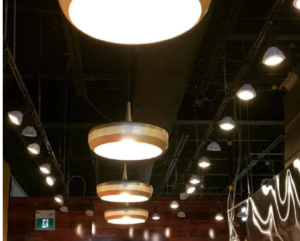Creating a branded office space that resonates with the company’s identity while maintaining a cohesive and appealing aesthetic can be a challenge. Interior designers can utilize various elements, including colors, signage, wayfinding, and lighting, to achieve this balance. Here are some strategies to consider:
Colors
Integrating the company’s brand colors into the office design is a powerful way to create a cohesive identity. Designers can select shades that reflect the brand’s personality, balancing bold colors with neutral tones to ensure a visually appealing environment.
- Psychological Impact: Different colors evoke distinct emotions and can influence productivity and mood. For example, blues promote calmness and focus, while yellows inspire creativity. A thoughtfully chosen color palette can enhance the office experience while aligning with the brand’s values.
- Accent Walls: Utilizing accent walls to feature brand colors or patterns can add visual interest and depth to the space. Textured wallpapers or murals that tell the brand story contribute to an engaging environment.
Signage
Effective signage can serve as an important branding tool without disrupting the overall aesthetic of the office.
- Custom Signage: Thoughtfully designed signs using materials like wood, glass, or metal can create elegant displays that reflect the brand identity.
- Subtle Integration: Incorporating signage within architectural features, such as integrated LED screens or etched glass partitions, maintains a sleek look while minimizing visual clutter.
- Artistic Expression: Signage can also be an artistic statement. Custom pieces that reflect the brand ethos—like inspirational quotes or mission statements—enhance the overall ambiance and connection to the brand.
Wayfinding
Wayfinding is essential for guiding employees and visitors through the office, and it can be integrated seamlessly into the design.
- Intuitive Design: Designers should focus on creating intuitive pathways and landmarks that guide users naturally, reducing the need for excessive signage.
- Thematic Navigation: Using brand elements in wayfinding, such as themed colors or motifs to represent different areas, makes navigation seamless while reinforcing the brand identity.
- Interactive Elements: Incorporating interactive wayfinding tools like touchscreens or maps can enhance user experience, providing valuable information in an engaging manner while reflecting the brand’s aesthetics.
Lighting
Lighting plays a crucial role in creating the desired atmosphere while supporting branding efforts.
- Layered Lighting: A mix of ambient, task, and accent lighting creates a versatile environment. This approach allows for branding elements, such as logo projections or backlit signage, to be highlighted without overwhelming the design.
- Color Temperature: Selecting appropriate color temperatures can influence the office mood. Warm white light creates a welcoming space, while cooler tones can enhance focus and productivity.
- Feature Lighting: Statement light fixtures, such as chandeliers or sculptural pendants, can serve as focal points that resonate with the brand identity. Custom lighting designs incorporating brand colors or shapes can enhance recognition while contributing to the overall aesthetic.
By thoughtfully integrating colors, signage, wayfinding, and lighting, interior designers can create branded office spaces that resonate with the company’s identity without compromising aesthetics. This holistic approach ensures that the environment is not only functional but also visually appealing, enhancing the overall work experience.
Frequently Asked Questions (FAQ):
What is wayfinding?
- Signage: Clear, concise signs that provide directions, information, and location identification. This can include directional signs, informational displays, and regulatory signs.
- Landmarks: Distinctive features or objects that serve as reference points for navigation, helping people orient themselves within a space.
- Maps: Visual representations of the area that show key locations, pathways, and relationships between different spaces.
- Pathways: The physical routes people take to move through an environment, including hallways, corridors, and stairways. Effective wayfinding design considers the arrangement of these pathways to facilitate navigation.
What are some lighting types that work best in an office space?
1. Ambient Lighting
- Purpose: Provides overall illumination for the entire space, creating a comfortable level of brightness without glare.
- Options: Ceiling-mounted fixtures, recessed lighting, or pendant lights can be used to achieve ambient lighting. Choosing fixtures with adjustable brightness can enhance flexibility based on the time of day or specific tasks.
2. Task Lighting
- Purpose: Focuses on specific areas where detailed work is performed, such as desks, workstations, or meeting rooms.
- Options: Desk lamps, adjustable LED task lights, or under-cabinet lighting can provide direct light to reduce eye strain and improve productivity. Dimming options can further enhance comfort.
3. Accent Lighting
- Purpose: Highlights specific areas or features within the office, such as artwork, architectural details, or branding elements.
- Options: Spotlights, track lighting, or wall-mounted fixtures can be used to draw attention to focal points in the space while adding visual interest.
4. Natural Lighting
- Purpose: Enhances mood and well-being, reduces reliance on artificial lighting, and can improve energy efficiency.
- Options: Maximizing natural light through windows, skylights, or glass partitions can create a brighter, more inviting atmosphere. Using light-filtering window treatments can help control glare while still allowing light to enter.
5. Color Temperature
- Considerations: The color temperature of lighting can significantly impact the ambiance.
- Cool White (4000K-5000K): Promotes focus and productivity, ideal for task-oriented areas.
- Warm White (2700K-3000K): Creates a cozy and inviting atmosphere, suitable for break areas or lounges.
6. Energy-Efficient Options
- LED Lighting: LED fixtures are energy-efficient, have a long lifespan, and are available in various styles and color temperatures. They can help reduce energy costs and lower the environmental impact of the office.
7. Layered Lighting
- Approach: Combining different types of lighting (ambient, task, and accent) creates a layered effect that enhances functionality and aesthetics. This approach allows for flexibility in adjusting light levels for various tasks and activities throughout the day.
